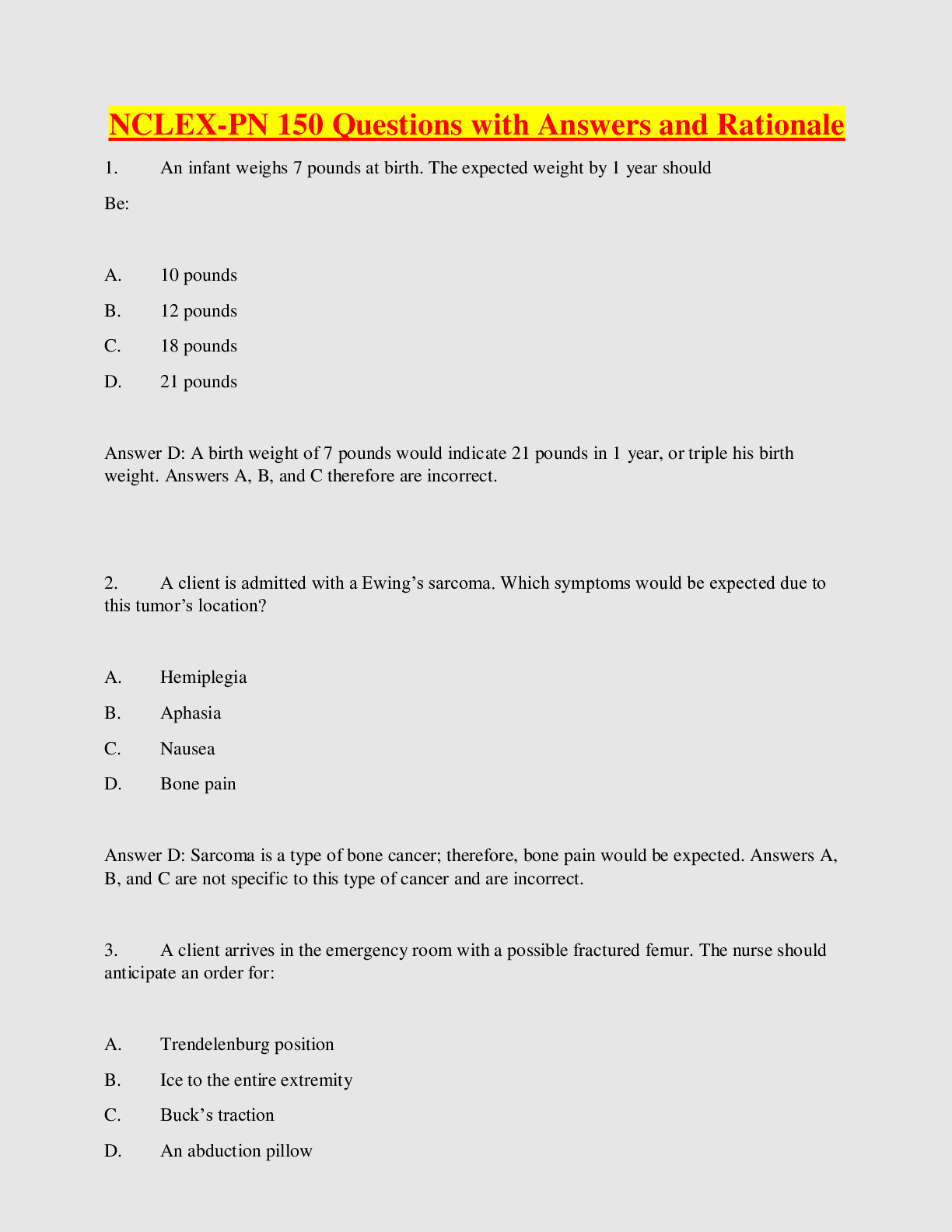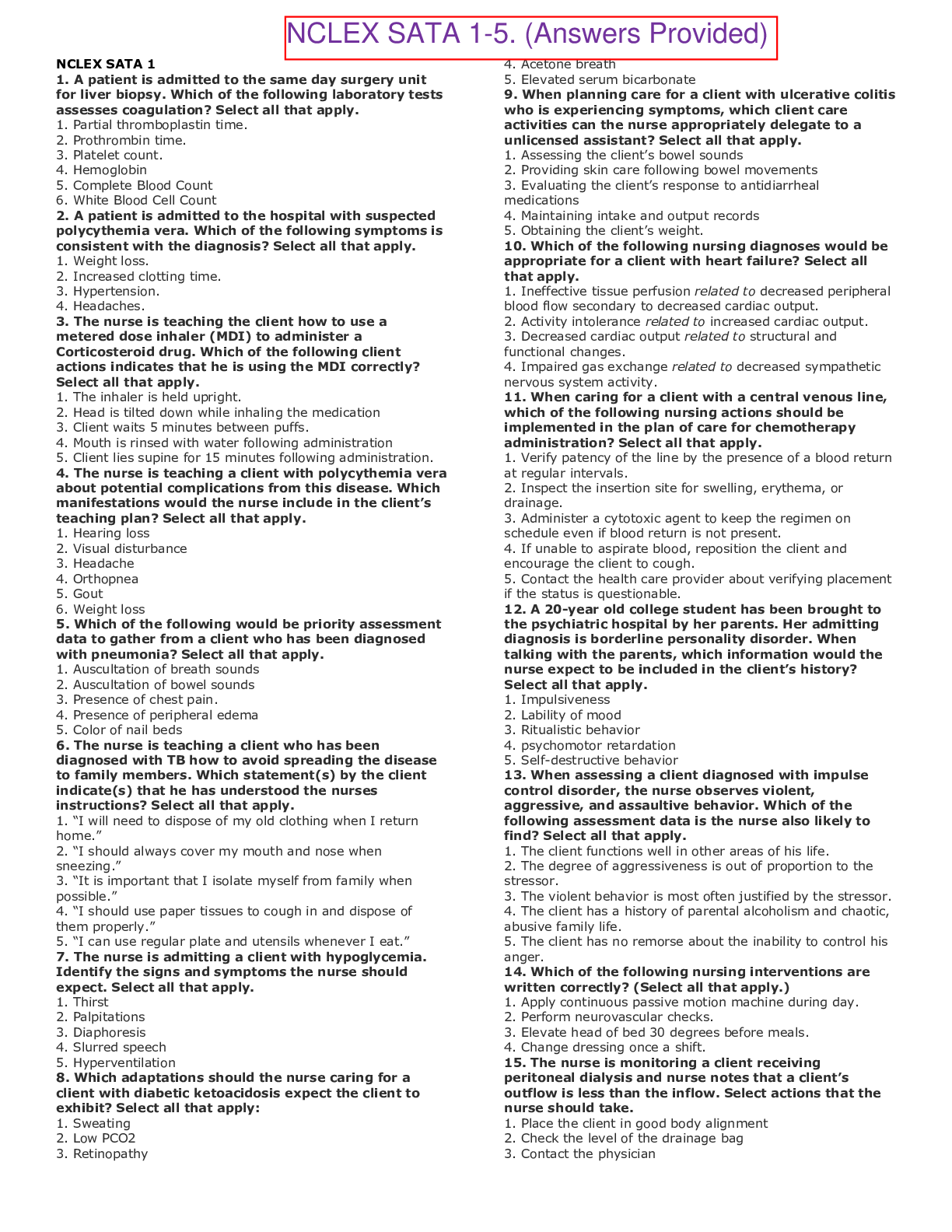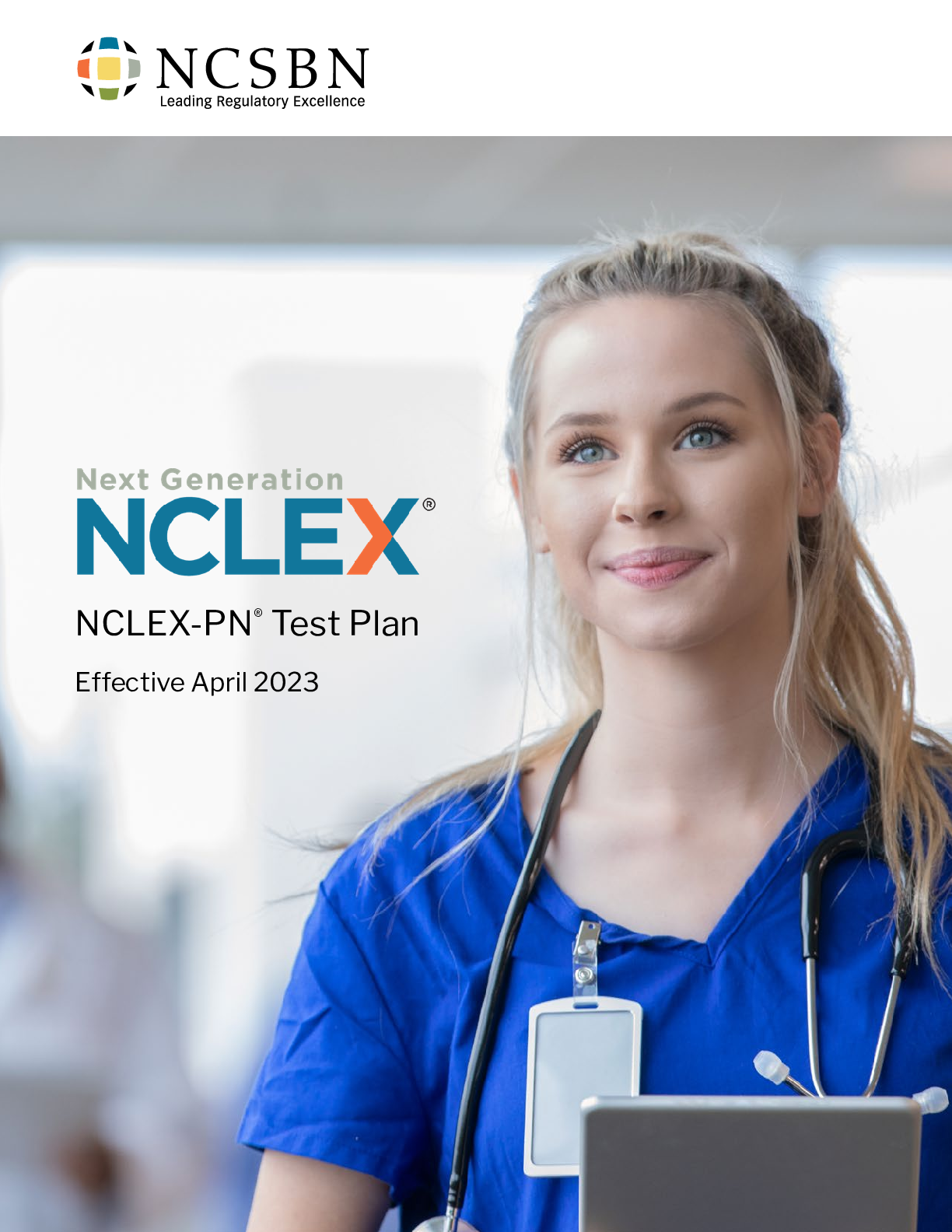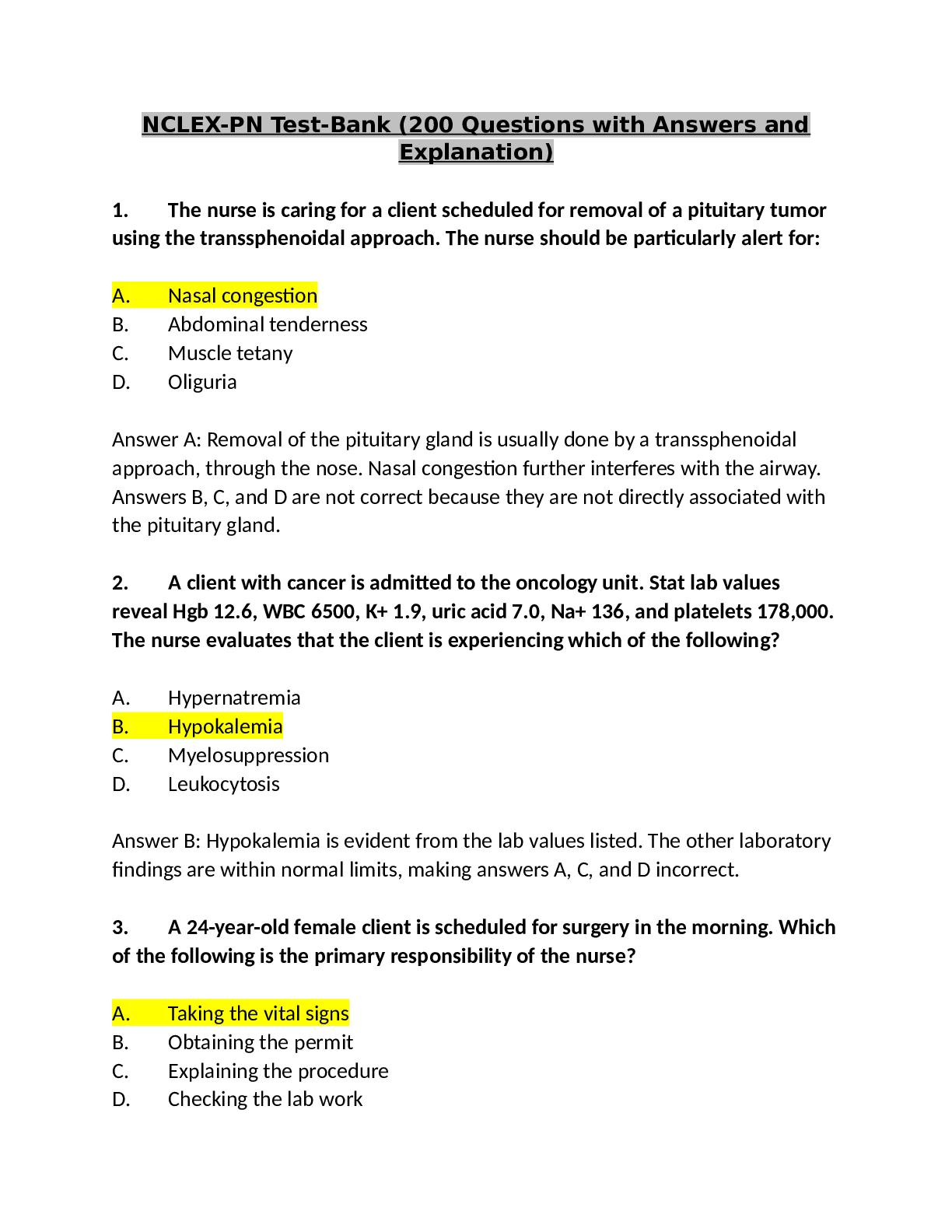Medical Studies > NCLEX-PN > NCLEX Question Trainer Explanations Test 6 | Med Surg 2210 NCLEX TEST 6 WITH EXPLANATIONS (All)
NCLEX Question Trainer Explanations Test 6 | Med Surg 2210 NCLEX TEST 6 WITH EXPLANATIONS
Document Content and Description Below
NCLEX Question Trainer Explanations Test 6 | Med Surg 2210 NCLEX TEST 6 WITH EXPLANATIONS 150+ Questions and answers The nurse returns to the nurse’s station after making client rounds and finds f... our phone messages. Which of the following messages should the nurse return FIRST? 1. A client with hepatitis A who states, “My arms and legs are itching.” 2. A client with a cast on the right leg who states, “I have a funny feeling in my right leg.” 3. A client with osteomyelitis of the spine who states, “I am so nauseous that I can’t eat.” 4. A client with arthritis who states, “I am having trouble sleeping at night.” Strategy: Eliminate the most stable clients. (1) caused by accumulation of bile salts under the skin; treat with calamine lotion and antihistamines (2) correct—may indicate neurovascular compromise; requires immediate assessment (3) requires follow-up but not highest priority (4) requires assessment but not the highest priority 2. Following hip replacement surgery, an elderly client is ordered to begin ambulation with a walker. Which of the following statements by the nurse is BEST? 1. “Sit in a low chair for ease in getting up to use the walker.” 2. “Make sure rubber caps are in place on all four legs of the walker.” 3. “You will begin weight-bearing on the affected hip soon.” 4. “Practice tying your own shoes before you begin ambulating.” Strategy: All answers are implementations. Determine the outcome of each answer choice. Is it desired? (1) full weight bearing or flexion of the hip greater than 90° should be avoided for four to six weeks (2) correct—intact rubber caps should be present on walker legs to prevent accidents (3) full weight bearing or flexion of the hip greater than 90° should be avoided for four to six weeks (4) full weight bearing or flexion of the hip greater than 90° should be avoided for four to six weeks NCLEX Question Trainer Explanations Test 63. A 22-year-old woman comes to the hospital at term in the early stages of labor. A diagnosis of complete placenta previa is made. It would be MOST important for the nurse to take which of the following actions? 1. Start an IV of terbutaline (Brethine) and monitor the patient’s vital signs closely. 2. Prepare the patient for an immediate cesarean section. 3. Maintain the patient on bedrest until spontaneous vaginal delivery is achieved. 4. Monitor the patient’s length and duration of contractions. Strategy: Answers are both assessments and implementations. Is the assessment appropriate? No. Determine the outcome of each implementation. Is it desired? (1) implementation, Brethine used to delay delivery in preterm labor (2) correct—implementation, cannot deliver vaginally (3) implementation, cannot deliver vaginally (4) assessment, cannot deliver vaginally, cesarean section must be performed 4. Which of the following nursing observations would indicate to the nurse that a child with epiglottitis is having an early complication of hypoxemia? 1. Heart rate of 148 beats per minute. 2. Bluish discoloration of the skin. 3. Bluish discoloration around the mouth. 4. Difficulty swallowing. Strategy: Determine how each answer choice relates to epiglottitis. (1) correct—heart rate correlates with hypoxemia and is an early finding, along with restlessness (2) cyanosis, late sign (3) circumoral cyanosis, late sign (4) sign of epiglottitis 5. After stabilizing a client with severe multiple trauma injuries from a motor vehicle accident, which of the following actions by the nurse is BEST? 1. Limit visiting hours to promote optimal rest. 2. Arrange for clergy to visit with the client and family as requested. 3. Arrange for a psychologist to visit with the family. 4. Arrange for the family to meet with a social worker to discuss financial aid. Strategy: All answers are implementations. Determine the outcome of each answer. Is it desired? (1) inappropriate (2) correct—would provide the appropriate spiritual support necessary during a crisis (3) inappropriate for the data given in the situation (4) inappropriate for the data given in the situation Preparation for the Nursing Licensure Examination 386. The nurse’s aide comes to take a woman by wheelchair for a magnetic resonance imaging (MRI) scan of the head and neck. Which of the following observations, if made by the nurse, would require an intervention? 1. The woman removes her dentures and gives them to her husband. 2. The woman’s vital signs are: BP 120/70, pulse 80, respirations 12, temperature 99°F (37.3°C). 3. The woman has a nitroglycerine patch on her right chest area. 4. The woman has red nail polish on her fingers and toes. Strategy: “Require an intervention” indicates an incorrect action. (1) should be removed before the test (2) results are within normal limits (3) correct—should be removed before the test (4) unnecessary to check capillary refill 7. The neonatal nurse is instructing the family of a newborn about an apnea monitor. The nurse should be MOST concerned if a family member makes which of the following statements? 1. “We will be able to leave our baby for brief periods of time.” 2. “We plan to sleep by our baby’s crib.” 3. “We can remove the monitor during our baby’s bath.” 4. “A family member will closely watch the monitor all the time. Strategy: “MOST concerned” indicates that you are looking for an incorrect statement. (1) appropriate behavior (2) appropriate behavior (3) appropriate behavior (4) correct—indicates a feeling that monitor may not let them know if their infant stops breathing 8. A 20-year-old client has a cast applied for a fracture of the right femur. Three hours later, the client complains that it is hot and painful under his cast. Which of the following is the MOST appropriate action for the nurse to take? 1. Assess the cast for wet spots and increase air circulation in the room. 2. Check the circulation in his casted extremity and change the client’s position. 3. Take the client’s temperature and observe him for other signs of infection. 4. Medicate the client for pain and notify the physician of his complaint. Strategy: Answers are a mix of assessments and implementations. Does this situation require assessment? Yes. (1) heat is sign of pressure (2) correct—heat is sign of pressure, pressure limits circulation (3) too early to see signs of infection (4) all complaints must be investigated, medication would mask signs of pressure, assessment first step NCLEX Question Trainer 399. A 30-year-old woman is admitted to the hospital with dry mucous membranes and decreased skin turgor. The woman's vital signs are BP 120/70, temperature 101°F (38.3°C), pulse 88, respirations 14. Laboratory tests indicate the serum sodium is 150 mEq/L and the Hct is 48%. The nurse would expect the physician to order which of the following IV fluids? 1. D 5 NS. 2. 0.45% NaCl. 3. 0.9% NaCl. 4. Lactated Ringer’s. Strategy: All answers are implementations. Determine the outcome of each answer choice. Is it desired? (1) hypertonic solutions contraindicated in dehydration (2) correct—hypotonic solution, shifts fluid into intracellular space to correct dehydration (3) isotonic solution, not best with dehydration (4) isotonic solution used to replace electrolytes 10. Which of the following plans would be MOST appropriate for the nurse to use to prepare a 10-year-old for a cardiac catheterization? 1. Show a videotape specifically prepared for children about cardiac catheterization. 2. Provide the child with a pamphlet about the procedure and encourage him to read it. 3. Draw a picture of a heart and explain where the tube will go and what the doctor will see. 4. Present a puppet show explaining the anatomy and physiology of the heart. Strategy: Think about the developmental stage of a 10-year-old. (1) video will provide correct information but is not best preparation for a school-age child (2) pamphlet will contain correct information but is not best preparation for a school-age child (3) correct—this plan will best prepare the child for the procedure (4) would be more appropriate for a younger child 11. Which of the following nursing actions is MOST important to provide a patient with effective pain relief? 1. Teach the patient about his pain. 2. Establish a trusting relationship with the patient. 3. Determine how various relaxation techniques affect the pain. 4. Provide alternative measures to relieve pain. Strategy: All answers are implementations. Determine the outcome of each answer choice. Is it desired? (1) not most important (2) correct—necessary to work with patient to identify interventions to relieve pain (3) part of intervention and evaluation phase (4) only a portion of interventions used to relieve pain Preparation for the Nursing Licensure Examination 4012. A client with a necrotizing spider bite is to perform his own dressing changes at home. The nurse is aware that which of the following statements, if made by the client, indicates a correct understanding of aseptic technique? 1. “I need to buy sterile gloves to redress this wound.” 2. “I should wash my hands before redressing my wound.” 3. “I should keep the wound covered at all times.” 4. “I should use an over-the-counter antimicrobial ointment.” Strategy: Answers are implementations. Determine the outcome of each answer choice. Is it desired? (1) not most important (2) correct—indicates understanding of asepsis, whose hallmark is handwashing (3) is not possible to carry out (4) should use only the prescribed medications on the wound 13. An adult woman is admitted to an acute locked psychiatric unit one month prior to an election. She requests the opportunity to vote in the upcoming election. Which of the following responses by the nurse is BEST? 1. “You are not eligible to vote because you are a psychiatric patient.” 2. “I’ll make the appropriate arrangements for you to vote.” 3. “You may vote only if you are discharged by Election Day.” 4. “I’ll contact the Election Board to see if you are registered to vote.” Strategy: Determine the outcome of each answer choice. (1) psychiatric patients do not forfeit their constitutional rights (2) correct—patient can vote by absentee ballot (3) can vote by absentee ballot (4) not the nurse’s responsibility 14. The nurse has administered sublingual nitroglycerin (Nitrostat) to a client complaining of chest pain. Which of the following observations is MOST important for the nurse to report to the next shift? 1. The client indicates the need to use the bathroom. 2. Blood pressure has decreased from 140/80 to 90/60. 3. Respiratory rate has increased from 16 to 24. 4. The client indicates that the chest pain has subsided. Strategy: The topic of the question is unstated. Read answer choices for clues. (1) not a side effect of this medication (2) correct—hypotension is significant side effect of nitroglycerin; although effect may be transient, BP should be closely observed to ensure that it does not continue to decrease (3) not a side effect of this medication (4) an expected outcome NCLEX Question Trainer 4115. One of the goals the nurse and a client with posttraumatic stress disorder (PTSD) mutually agreed upon is that he will increase his participation in out-of-the apartment activities. Which of the following recommendations, if made by the nurse, will be MOST therapeutic to achieve this goal? 1. Take a day trip with a friend. 2. Take an eleven-minute bus ride alone. 3. Join a support group and participate in a victim assistance organization. 4. Take a ten-minute walk with his wife around the block. Strategy: All answers are implementations. Determine the outcome of each answer choice. Is it desired? (1) reasonable recommendation to begin using in a systematic desensitization program after the crisis is alleviated (2) reasonable recommendation to begin using in a systematic desensitization program after the crisis is alleviated (3) correct—support groups of people who have suffered similar acts of violence can be helpful and supportive to teach clients how to deal with the traumatizing situation and the emotional aftermath (4) reasonable recommendation to begin using in a systematic desensitization program after the crisis is alleviated 16. A client is scheduled for a traditional abdominal cholecystectomy. Which of the following statements, if made by the nurse to the client the night before surgery, is MOST important? 1. “It is important for you to eat foods from every level of the food pyramid and avoid excessive fats in your diet.” 2. “Place the pillow against your abdomen, take three deep breaths, hold your breath, and then cough two or three times.” 3. “There will be a machine available to you after surgery for you to use to continuously receive pain medication.” 4. “You may come back from surgery with a tube in your nose that drains your gall bladder.” Strategy: All answers are implementations. Determine the outcome of each implementation. Is it desired? (1) not most important initially, teaching should be done before discharge (2) correct—should be done every two hours to prevent respiratory complications, splinting prevents abdominal jarring (3) PCA pumps used postoperative but medication is administered intermittently (4) NG tube used to drain stomach, T-tube used to drain common bile duct Preparation for the Nursing Licensure Examination 4217. A 22-year-old mother of a 4-year-old boy comes to the antepartal clinic. Her second pregnancy has just been confirmed. During this initial visit, it MOST important for the nurse to 1. assess the client’s feelings about pregnancy, labor, and delivery. 2. obtain a history of the client’s last labor and delivery. 3. determine how the client’s 4-year-old feels about the pregnancy. 4. identify the client’s general health needs. Strategy: Think about each answer choice. (1) important data, priority is the here and now (2) important data, but not priority for first visit (3) important data, need to deal with the mother’s needs first (4) correct—optimal opportunity for preventative health maintenance 18. The nurse is preparing a client for a skin biopsy. Which of the following client statements should the nurse report to the physician? 1. “I’ve been taking aspirin for my sore knees.” 2. “Using lotion has helped my dry skin.” 3. “I went to the tanning salon yesterday.” 4. “I had a big breakfast this morning.” Strategy: Determine how the statements relate to skin biopsy. (1) correct—aspirin compounds can increase bleeding time and should not be taken prior to a surgical procedure (2) does not affect the accuracy or results of the biopsy (3) does not affect the accuracy or results of the biopsy (4) does not affect the accuracy or results of the biopsy - - - - - - - - - - - - - - - - - - - - - - - - - - - - - - - - 191. A patient is admitted with abdominal pain and nausea. The physician orders stool for guaiac times three days. The nurse asks the health care technician to obtain the stool specimen. Which of the following statements, if made by the technician, would require an intervention by the nurse? 1. “I'll remind the patient to use the bedpan instead of the bathroom toilet.” 2. “I'll use a tongue blade to collect a small amount of stool in a clean container.” 3. “I’ll get a couple of specimens this afternoon because the patient is having loose stools.” 4. “I'll ask the patient if he has ingested any red meat recently.” Strategy: Each answer choice is an implementation. Determine the outcome of each answer choice. Is it desired? (1) easier to get specimen (2) doesn’t need to be sterile container (3) correct—ordered to be collected over 3-day period (4) may cause false-positive reading NCLEX Question Trainer 101192. A 30-year-old woman is receiving levothyroxine sodium (Synthroid) 0.1 mg PO daily. Which of the following findings would indicate to the nurse that the client is getting favorable results from the medication? 1. Decreased blood pressure. 2. Increased urine output. 3. Decreased pulse rate. 4. Increased respiratory rate. Strategy: Determine how each answer choice relates to hypothyroidism. (1) characteristic of hypothyroidism, would indicate that medication is not working (2) correct—medication increases metabolic processes of body, including glomerular filtration, edema will decrease as water is excreted (3) characteristic of hypothyroidism, would indicate that medication is not working (4) respiratory rate may or may not be affected by medication 193. A 24-year-old woman who is 30 weeks pregnant is seen in the outpatient clinic for a routine visit. The nurse would be MOST concerned if the client made which of the following statements? 1. “During the day I seem to get hot flashes and chills.” 2. “I am having some trouble with constipation and hemorrhoids.” 3. “At the end of the day I have leg cramps.” 4. “When I put my hand on my abdomen, I can feel it tense and relax.” Strategy: “MOST concerned” indicates a complication. (1) correct—should be reported to the physician (2) common due to pressure of growing fetus (3) common due to compression of nerves supplying lower extremities or reduced calcium levels, should take oral calcium supplements if ordered, stretch until spasm is relieved (4) Braxton-Hicks contractions common, should rest and change position 194. The nurse prepares a 67-year-old man for an intravenous pyelogram (IVP). Which of the following information is MOST important for the nurse to obtain before the procedure? 1. The date of the client’s last EKG. 2. The time of the client’s last meal. 3. A list of the client’s allergies. 4. A list of the medications the client takes at home. Strategy: All answers are assessments. Determine why you would make the assessment and how it relates to the situation. (1) electrical activity of heart, not most important (2) should be NPO for 6–8 h, not most important (3) correct—involves injection of radiopaque dye, used to identify lesions and assess function, allergy to iodine is life-threatening (4) not most important Preparation for the Nursing Licensure Examination 102195. A client is receiving heparin via continuous IV infusion for management of deep vein thrombosis (DVT). The partial thromboplastin time (PTT) is 1.5 times greater than normal. Which of the following actions by the nurse is MOST appropriate? 1. Discontinue the heparin infusion. 2. Slow down the heparin infusion. 3. Check the prothrombin time (PT) results. 4. Continue to monitor the client. Strategy: Answers are a mix of assessments and implementations. Does this situation require validation? No. Determine the outcome of each answer. (1) no reason to discontinue or slow the infusion because the PTT is within a therapeutic range (2) no reason to discontinue or slow the infusion because the PTT is within a therapeutic range (3) prothrombin time (PT) test is useful for assessing warfarin (Coumadin) therapy (4) correct—expected result of heparin therapy is a prolonged PTT of 1.5 times the control, without signs of hemorrhage 196. The homecare nurse is visiting an elderly client with osteoarthritis. It would be MOST important for the nurse to include which of the following instructions? 1. “Swimming is the only helpful exercise for osteoarthritis.” 2. “Warm-up exercises should be done prior to exercising.” 3. “Exercises should be done routinely, even if severe joint pain occurs.” 4. “Isometric exercises are most helpful to prevent contractures.” Strategy: All answers are implementations. Determine the outcome of each answer choice. Is it desired? (1) swimming is only one helpful exercise (2) correct—warm-up or “stretching” exercises should always be done to begin and end exercising (3) severely painful joints should not be exercised (4) isometric exercises do not involve joint movement NCLEX Question Trainer 103197. The nurse observes a new graduate nurse palpating the uterine contractions of a 21-year-old primipara in active labor. Which of the following actions, if taken by the new graduate nurse, is MOST appropriate? 1. The graduate nurse places the palm of one hand on the fundus and moves the hand around the abdomen. 2. The graduate nurse places the heels of both hands on the lower abdomen and presses lightly. 3. The graduate nurse places one hand on the abdomen over the fundus and with the fingertips, presses gently. 4. The graduate nurse places the palms of the hands on either side of the abdomen and presses firmly. Strategy: “MOST appropriate” indicates that this is a priority question. All answers are implementations. Determine the outcome of each answer choice. Is it desired? (1) palpations should be done with fingertips, not palms of hands (2) palpations should be done with fingertips, not heels of hands (3) correct—done with fingertips (4) palpations should be done with fingertips, not palms of hands 198. The nurse is assigned a team with another registered nurse and an LPN. Which of the following patients should the nurse assign to the LPN? 1. A 67-year-old man who is NPO and scheduled for a transurethral resection of the prostate (TURP) in 3 hours. 2. A 53-year-old woman with an IV of 0.9% NaCl at 100 cc/h who had a lumbar laminectomy two days ago. 3. A 40-year-old woman with a Hemovac drain and a large surgical dressing from a mastectomy 2 days ago who is showing signs of depression. 4. A 27-year-old woman scheduled for discharge later today after receiving chemotherapy through a portacath for treatment of leukemia. Strategy: The LPN/LVN is assigned stable patients with expected outcomes. (1) needs preoperative teaching and assessment (2) correct—basic care needs can be met by the LPN/LVN, don’t make patient assignments based on equipment (3) needs therapeutic intervention, teaching, and assessment (4) needs assessment and teaching Preparation for the Nursing Licensure Examination 104199. The nurse knows that to manage at home alone following discharge from the hospital, an arthritic client must be able to perform which of the following tasks? 1. Climb up and down stairs. 2. Lace and tie his/her shoes. 3. Comb his/her hair and brush his/her teeth. 4. Walk without assistance. Strategy: Think about the significance of each answer choice and how it relates to arthritis. (1) stairs can be eliminated in the client’s environment (2) is a modifiable problem with the use of slip-on shoes (3) correct—is part of basic hygiene and grooming that must be done daily to maintain overall health (4) is not necessary for independence; walker or wheelchair may be used 200. A nurse was sued for malpractice but is proved innocent. Which fact from the case was decisive in determining the outcome? 1. Negligence was implied. 2. The suit was filed under the law of negligent tort. 3. No harm was actually suffered by the patient. 4. The nurse failed to give competent care. Strategy: Think about each answer. (1) negligence is the unintentional failure of an individual to perform an act that a reasonable person would or not would perform in similar circumstances; can be an act of omission or commission (2) tort is a legal term that means a wrongful act that results in injury, loss, or damage (3) correct—required elements of malpractice are duty, breadth of duty, causation, and injury (4) would be considered negligence [Show More]
Last updated: 1 year ago
Preview 1 out of 70 pages
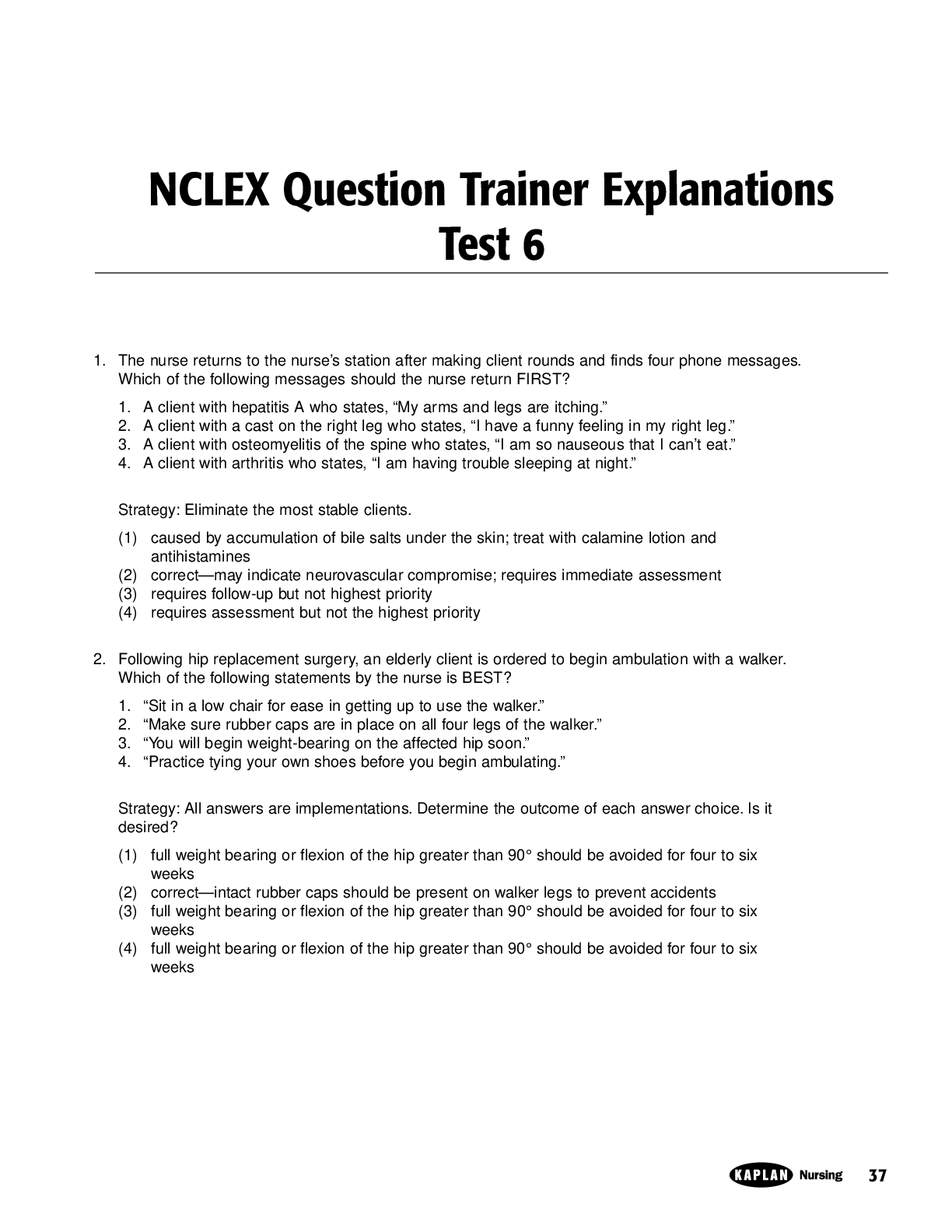
Reviews( 0 )
Document information
Connected school, study & course
About the document
Uploaded On
Aug 05, 2020
Number of pages
70
Written in
Additional information
This document has been written for:
Uploaded
Aug 05, 2020
Downloads
0
Views
103

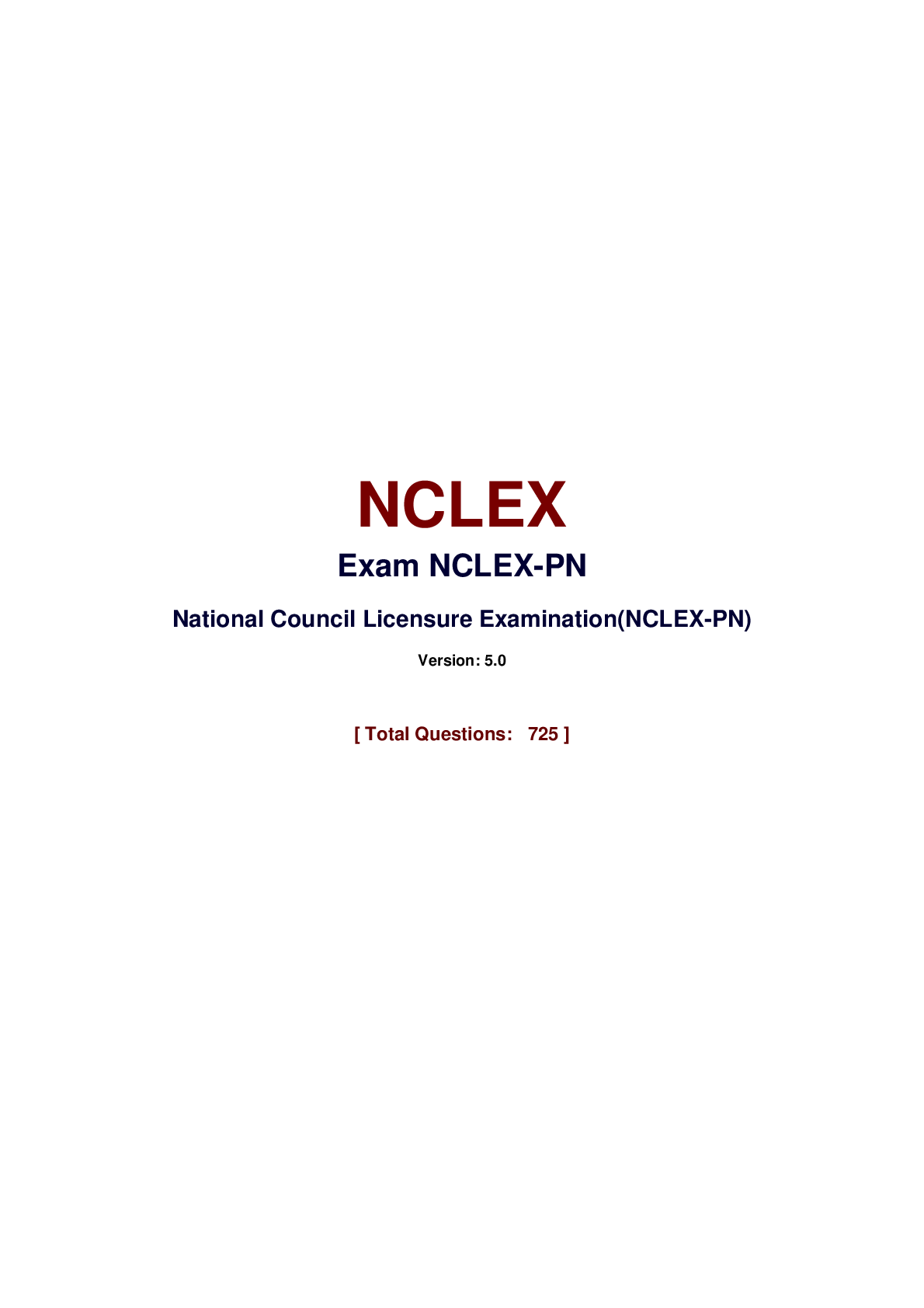

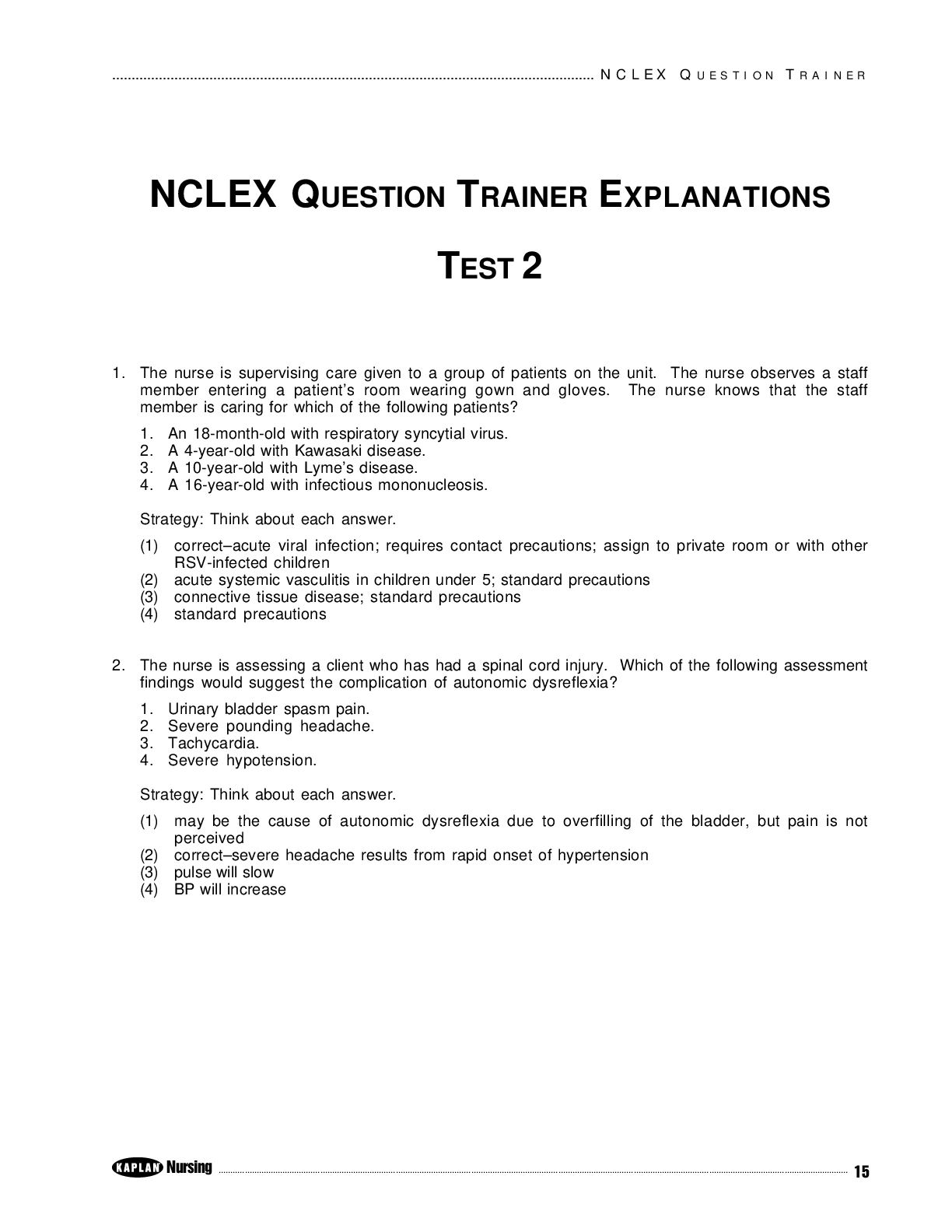
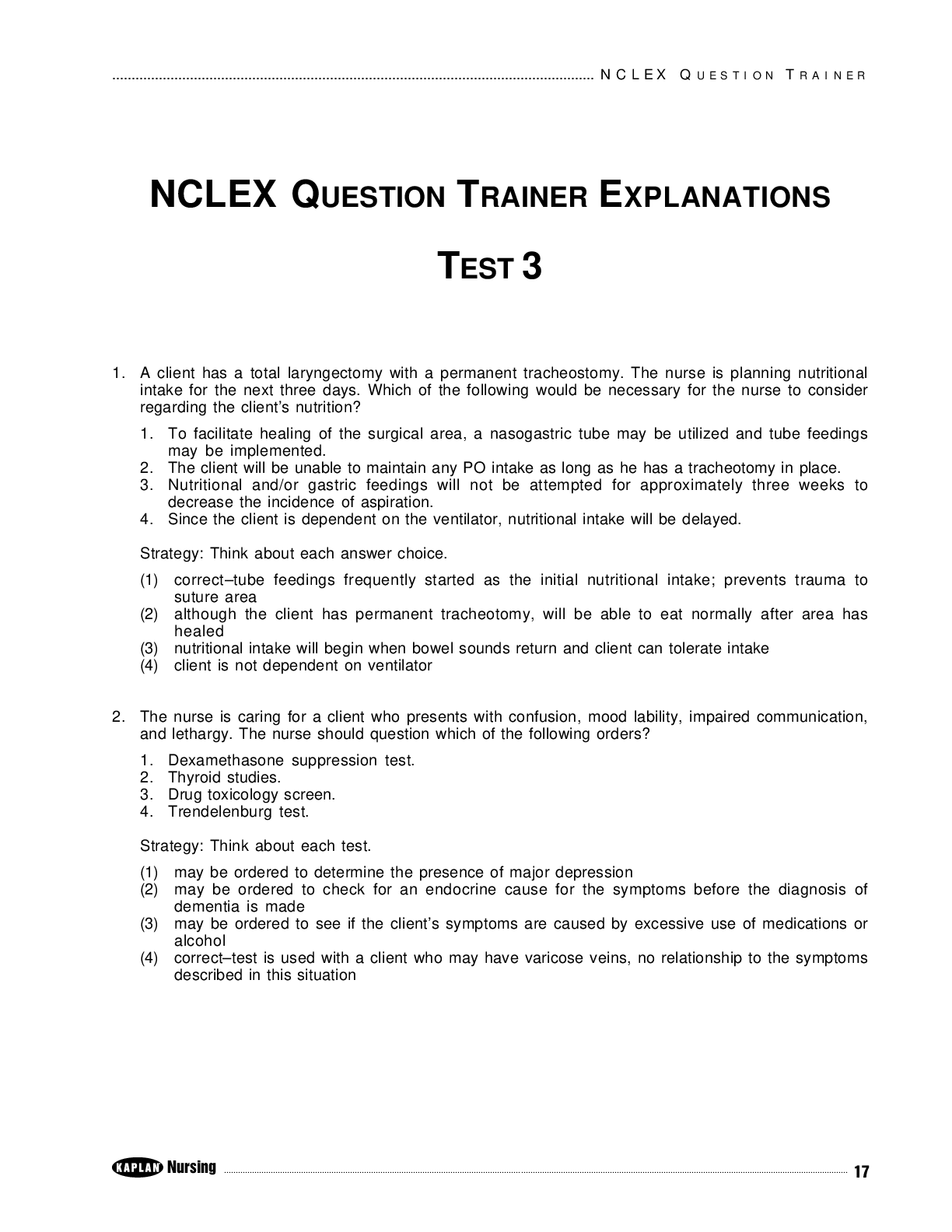
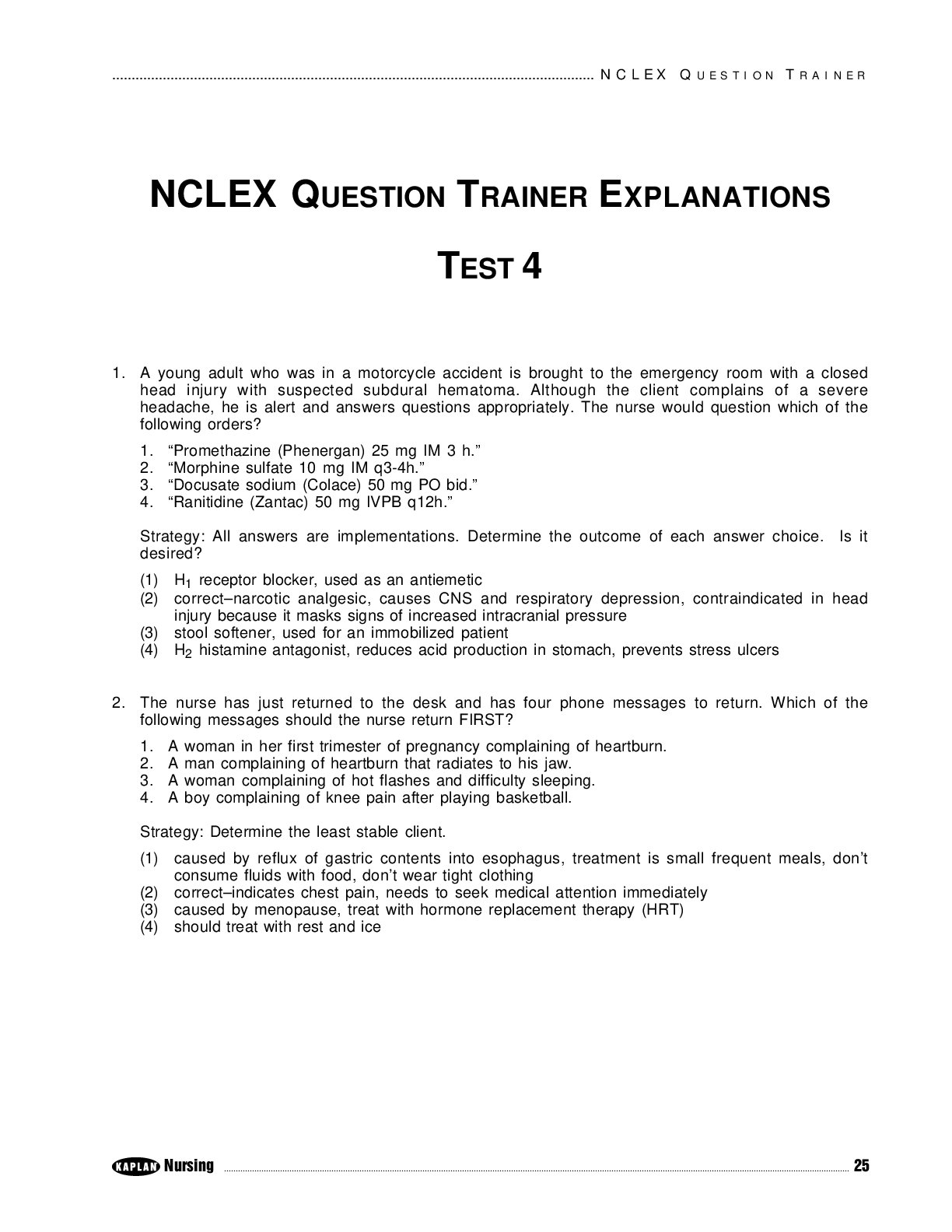
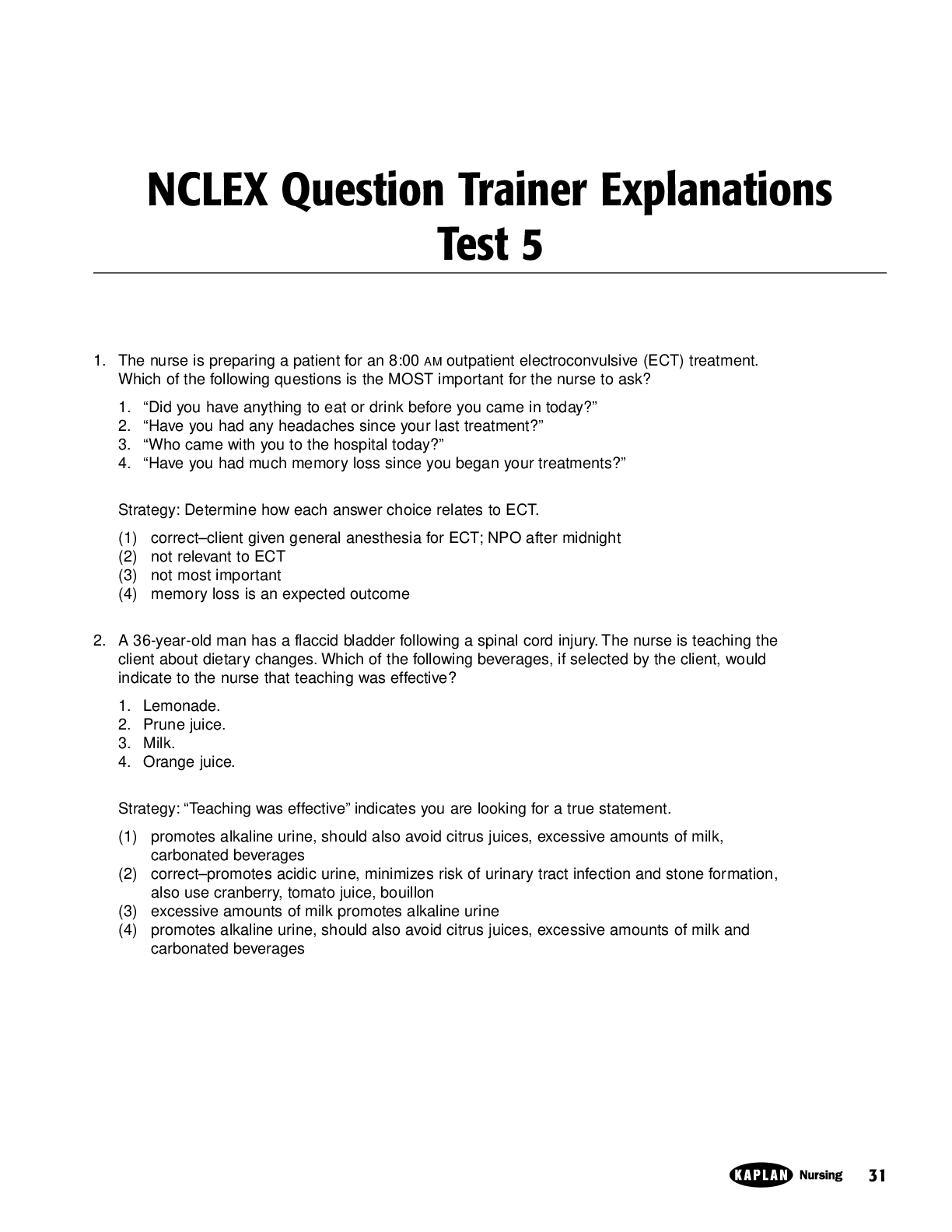
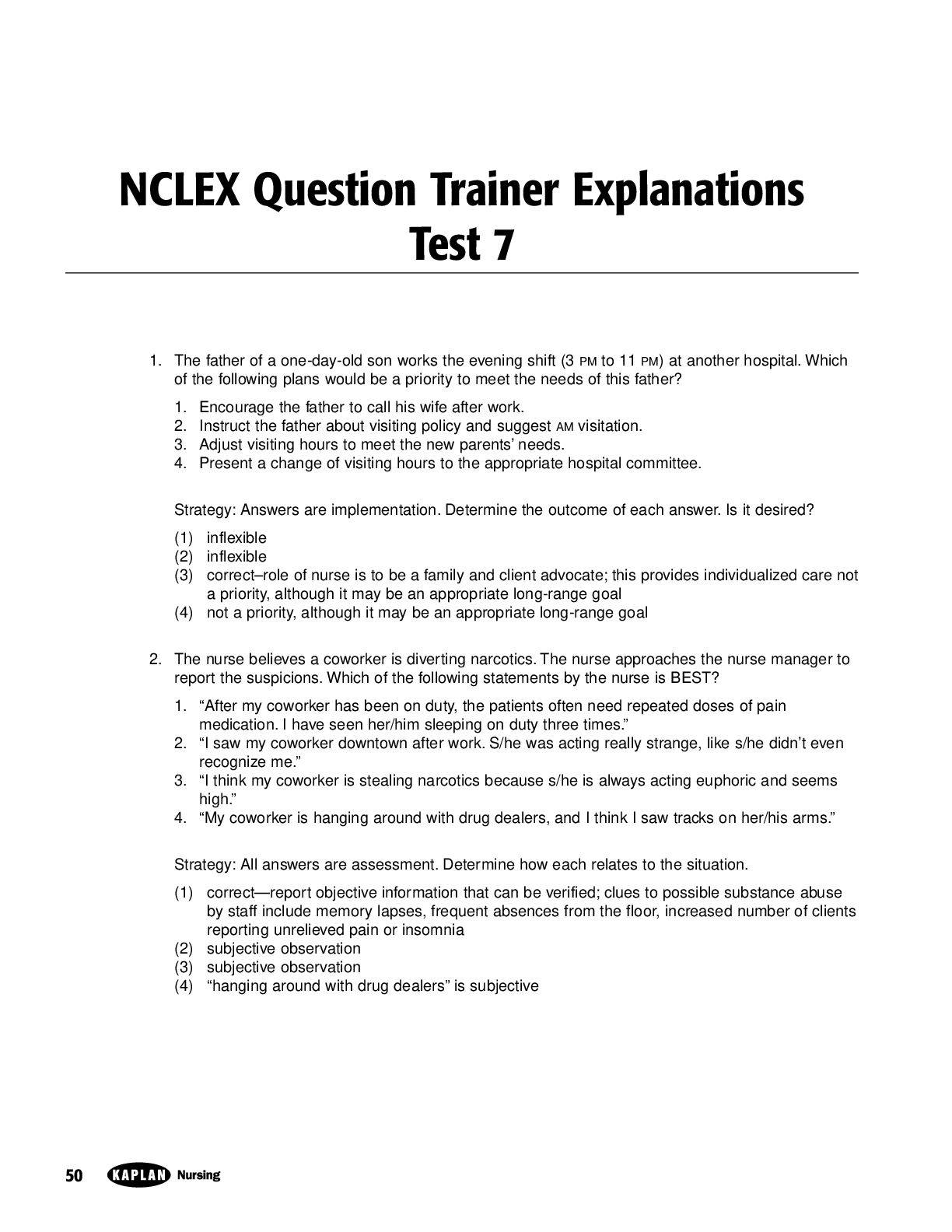
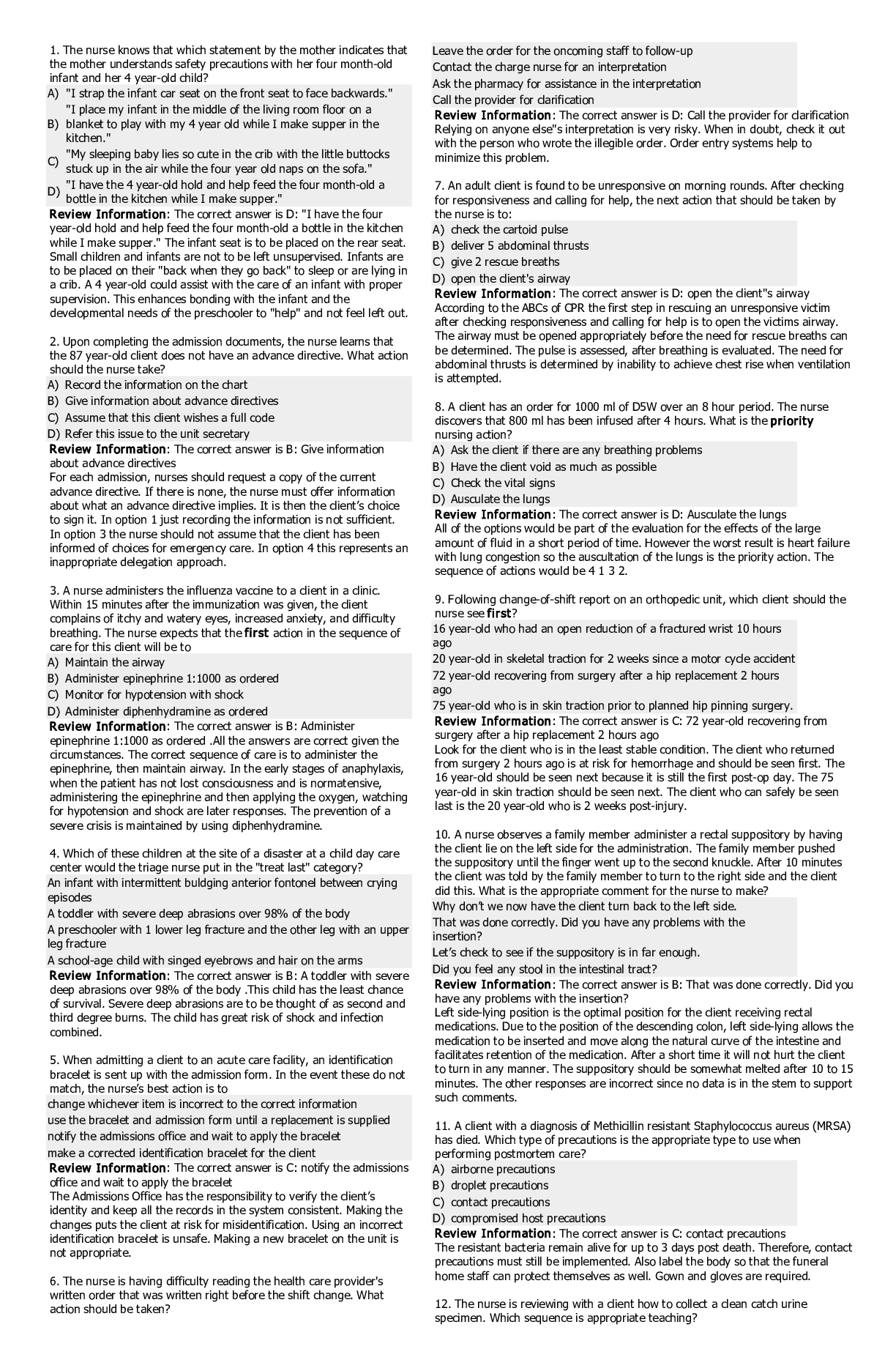
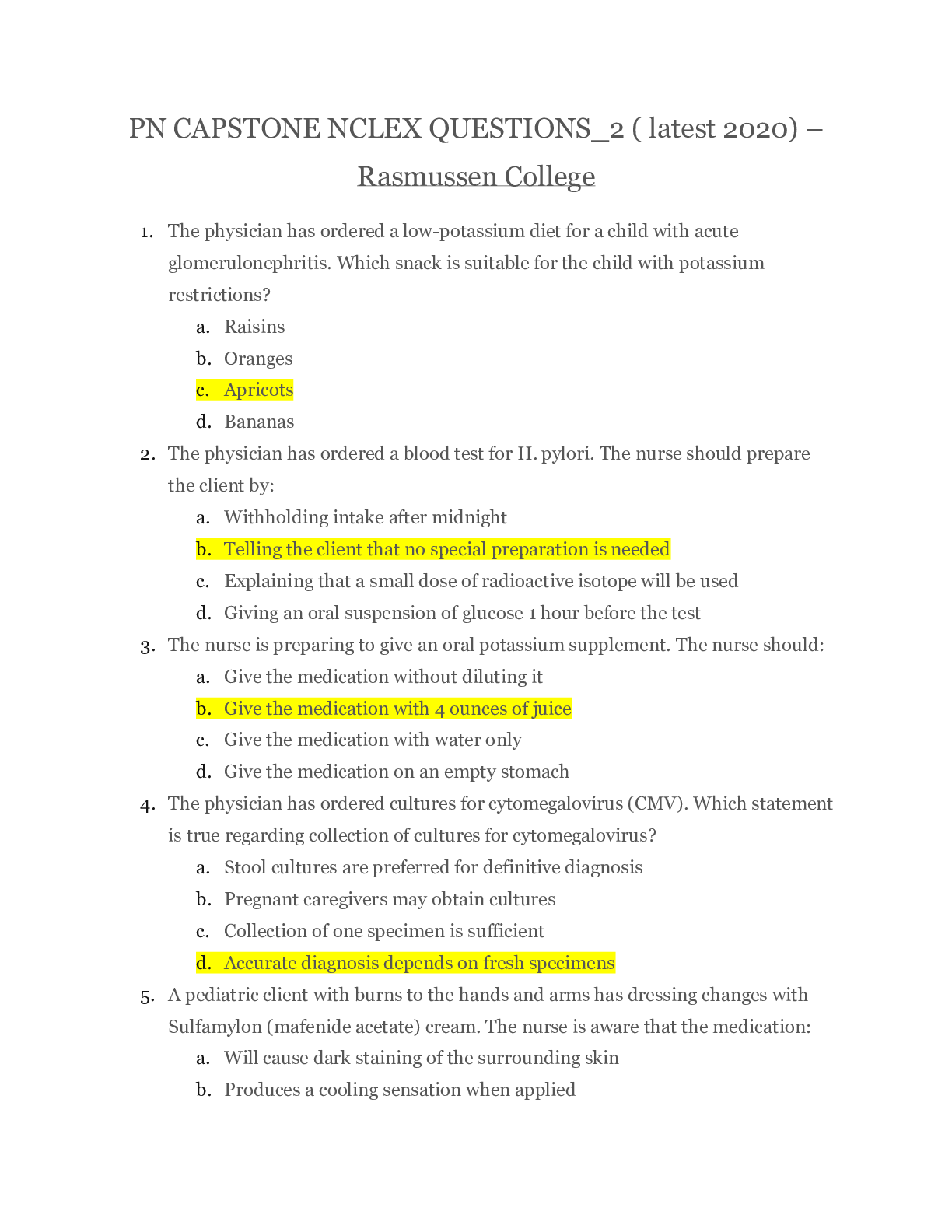

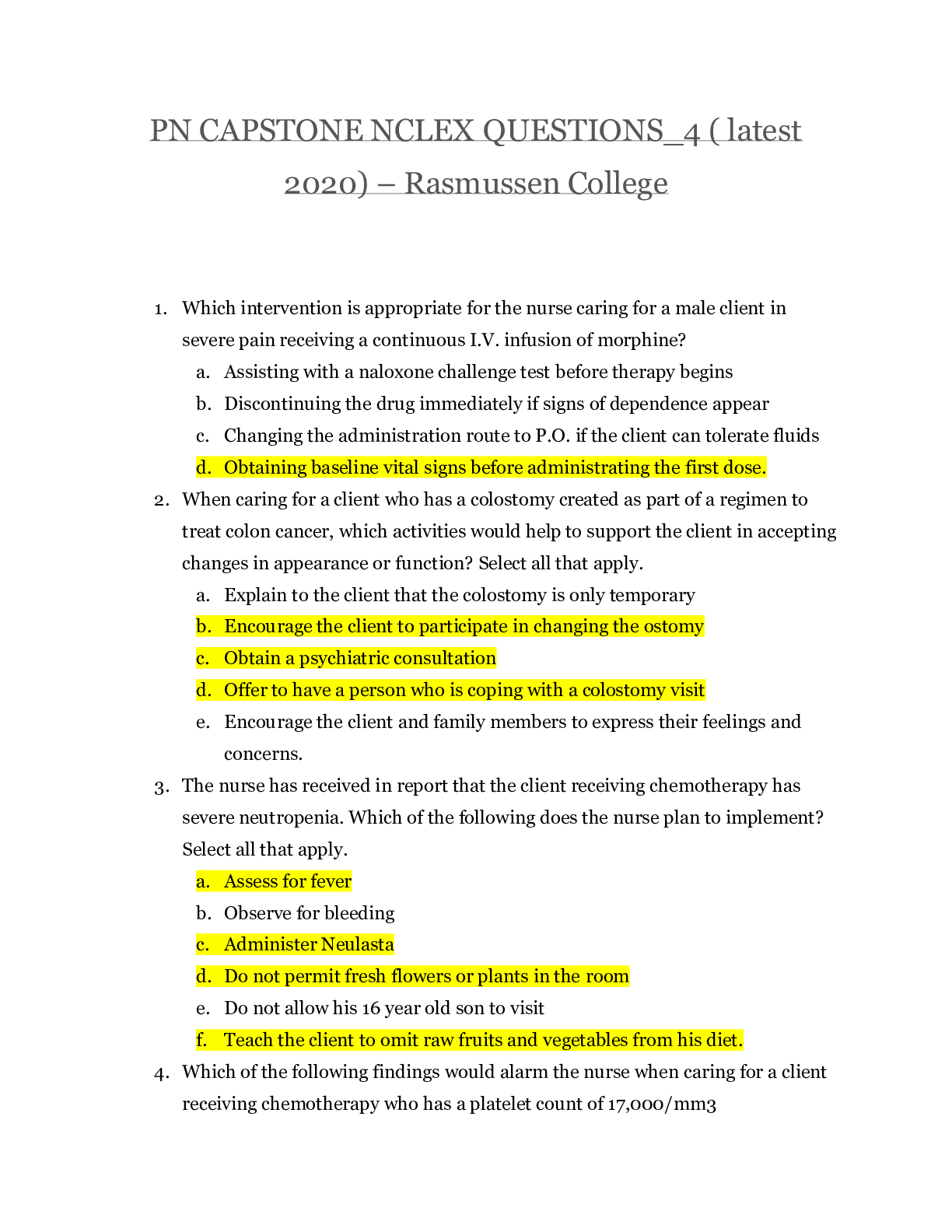


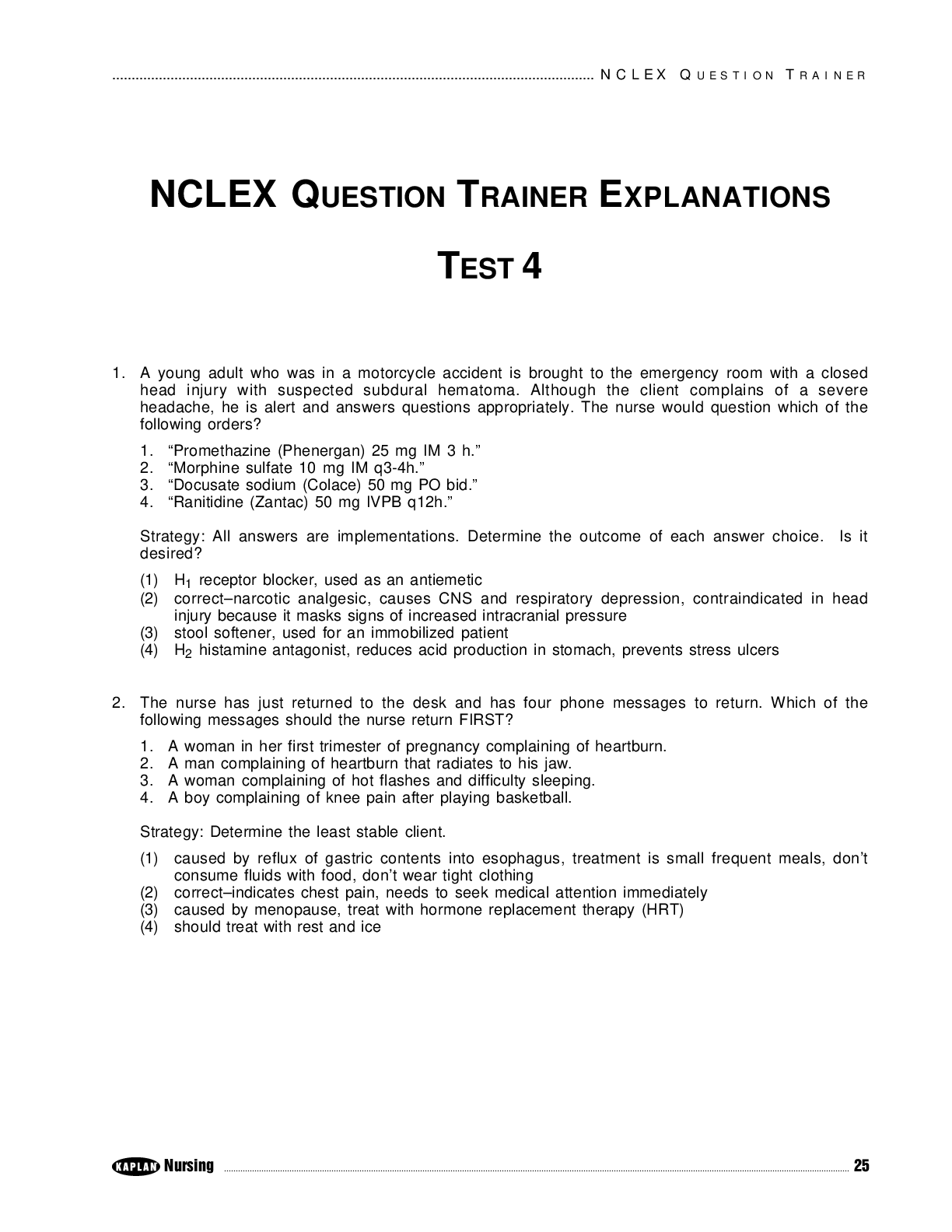
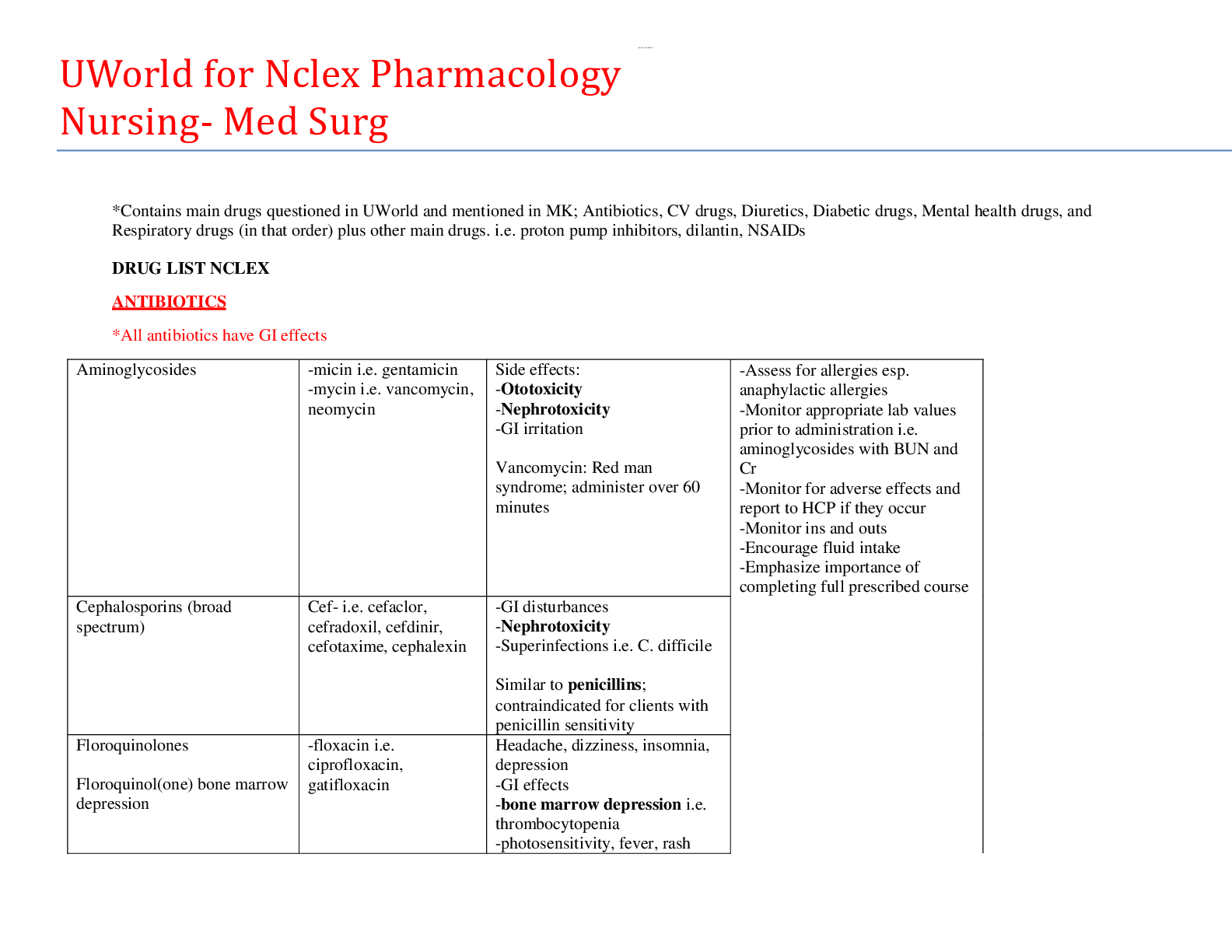

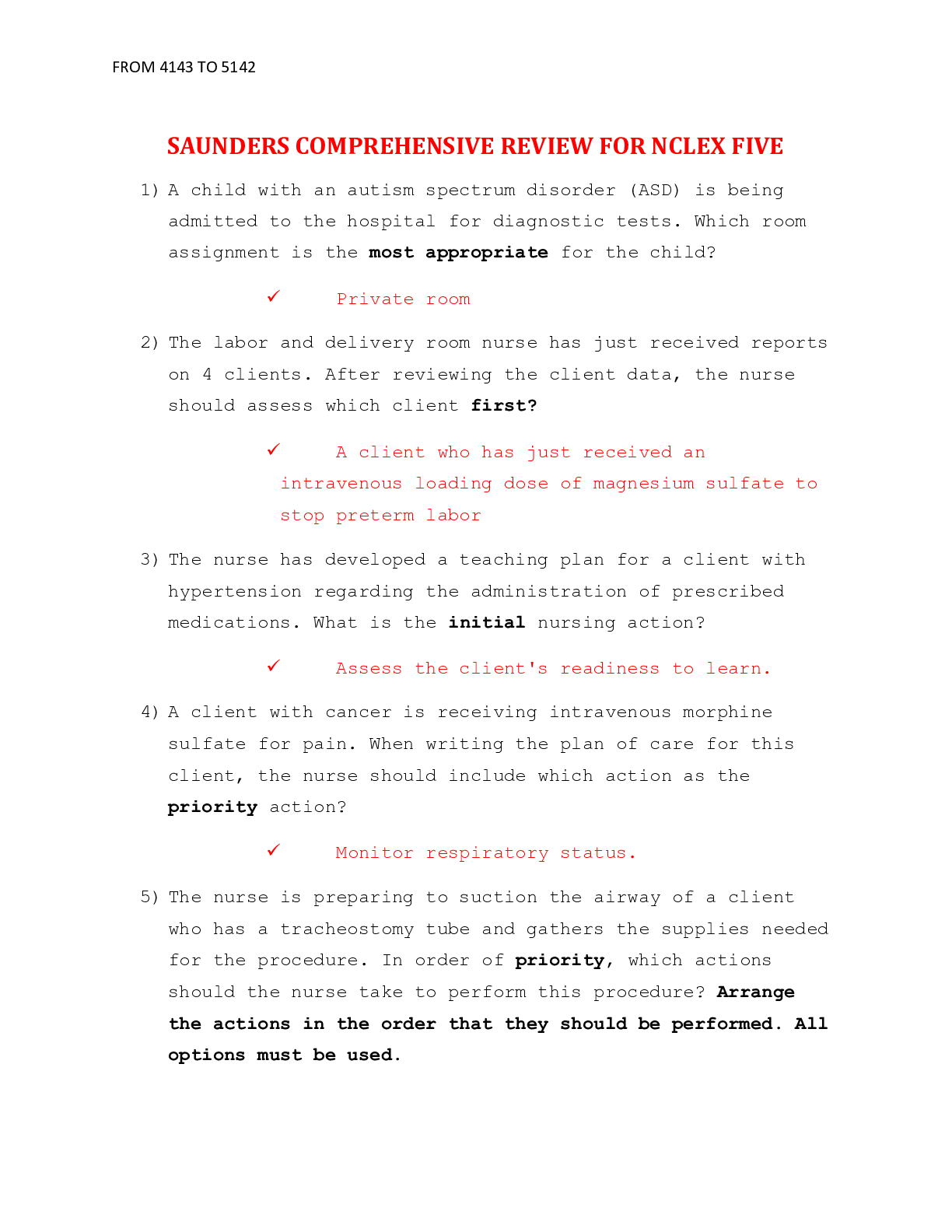
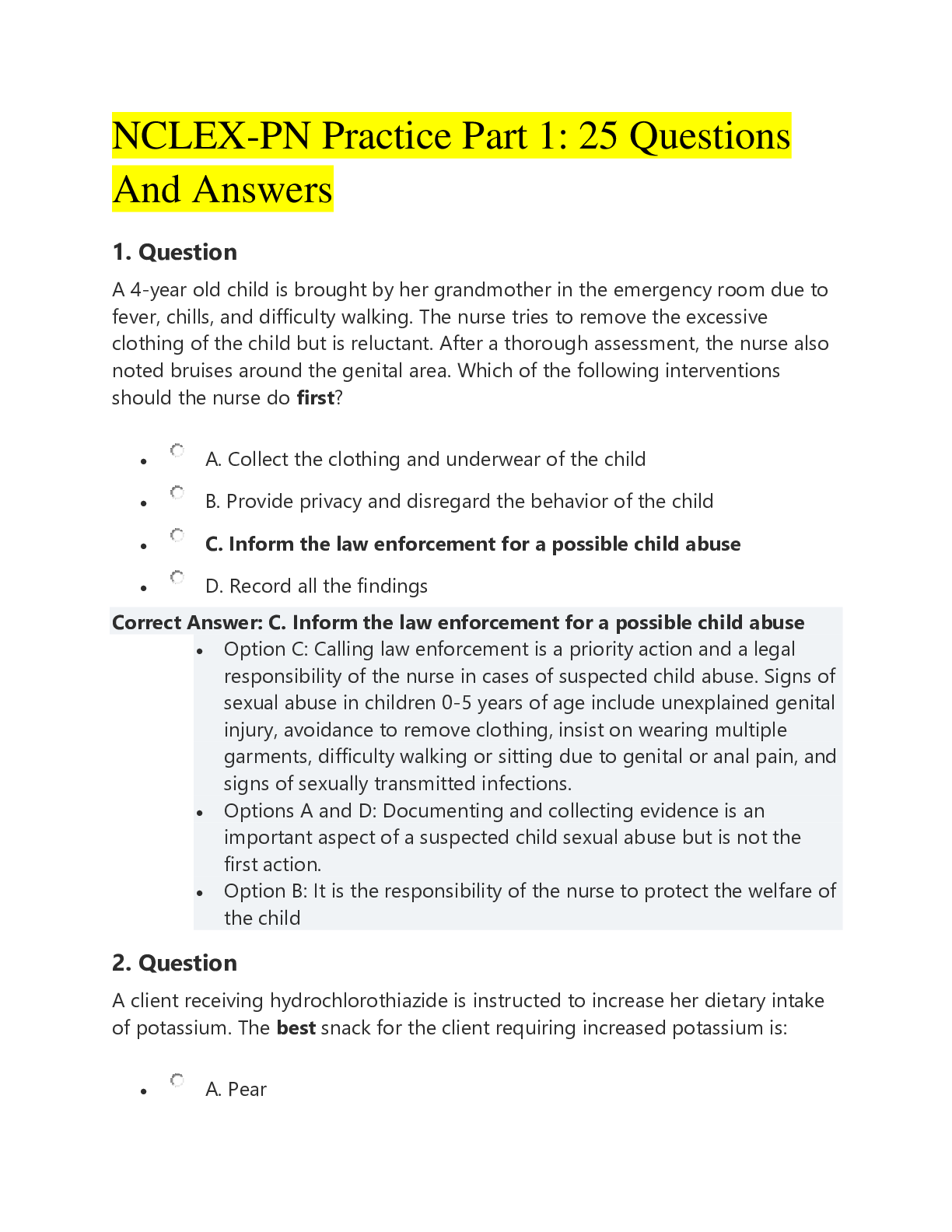
.png)
